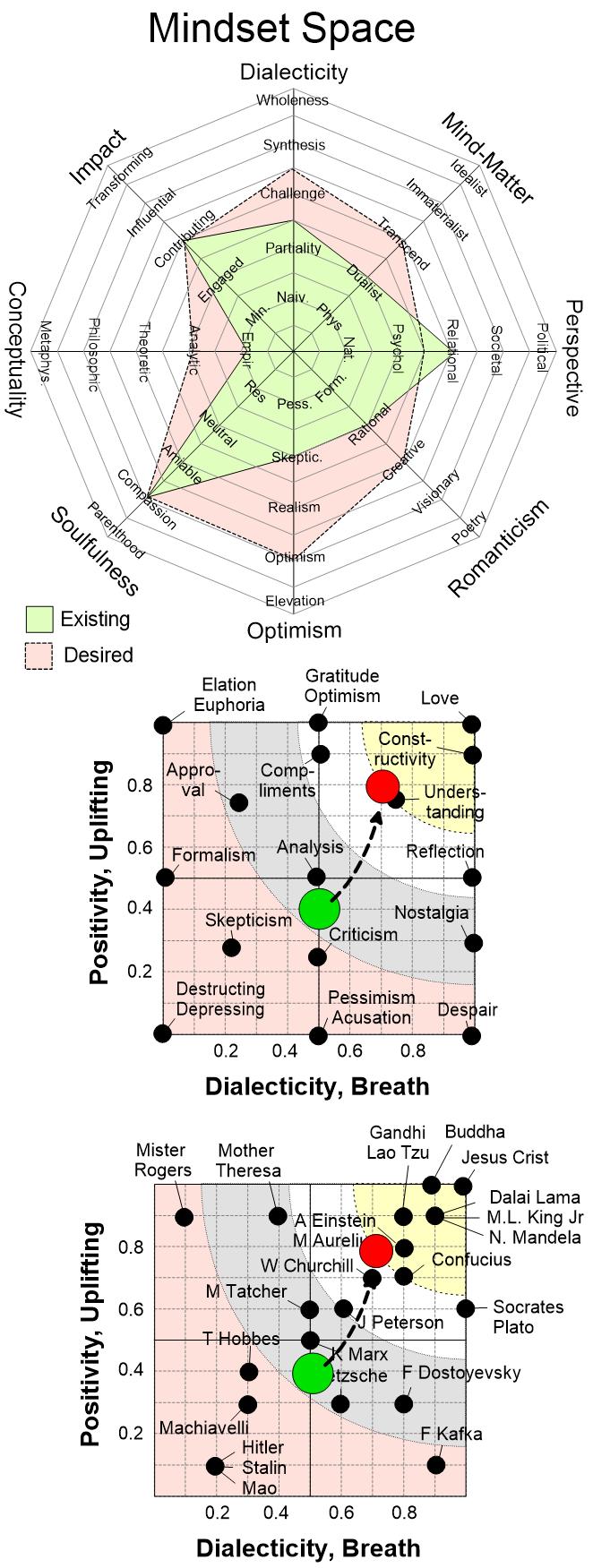
The following parameters were developed to differentiate between various types of famous thinkers, such as Lao Tzu and George Orwell. All parameters form ‘dialectical pairs’, ensuring inherent balance and circular causation, thus enabling more insightful “mindset mapping“.
Dialecticity (Scope, Dimensionality) – the breadth and depth of views:
D = 0: Dogma. Firmly fixed in one’s beliefs.
D = 0.2: Naive Certainty. Basic views, with minimal exploration.
D = 0.3: Opportunism. Adjusts views for immediate gain.
D = 0.4: Functional Idealist. Dominantly pragmatic with some openness to broader ideas.
D = 0.5: Dual-Aspect. Juggles theory with practice but may lean more towards one.
D = 0.6: Analytical Thinker. Delves deep into ideas, philosophically rich but may not always reach a conclusive synthesis.
D = 0.7: Pragmatic Pluralism. Open to a multitude of ideas, selects based on practicality but with a depth of understanding.
D = 0.8: Literary Synthesis. Explores human nature and the world through narratives, weaving intricate understandings of different views.
D = 0.9: Philosophical Synthesis. Deeply contemplates the nature of existence, ethics, and the universe, aiming to integrate varied views.
D = 1.0: Holism. Achieves a unified understanding and harmony among all perspectives.
Mind-Matter – the balance between material and spiritual considerations:
MM = 0.0: Materialist – Views matter as primary; mental/spiritual elements are secondary outcomes of material processes.
MM = 0.2: Physicalist – Favors matter but recognizes some non-material influences.
MM = 0.4: Dualist – Values mental and physical as independent, equal forces.
MM = 0.6: Transcendent – Prioritizes mental/spiritual slightly over material but sees importance in both.
MM = 0.8: Immaterialist – Leans towards mind/spirit but admits material as a reflection of the mental.
MM = 1.0: Idealist – Views reality as fundamentally mental or spiritual; materiality is a mental manifestation.
Perspective – the focus of the content, ranging from universal truths to political insights:
Pe = 0.0: Universal – Tuned into cosmic truths and universal principles, akin to Lao Tzu.
Pe = 0.2: Natural – Aligned with nature, exploring tangible phenomena and universal laws.
Pe = 0.4: Introspective – Delving into inner worlds, embracing psychological and mystical constructs.
Pe = 0.6: Relational – Centered on close personal relationships like family and friends.
Pe = 0.8: Societal – Engaged with societal norms, structures, and cultural dynamics.
Pe = 1.0: Political – Zeroed in on politics, governance, and global dynamics, reminiscent of George Orwell.
Romanticism – the blend of logic and emotion:
R = 0: Formalist – Steadfast in following rules; precise and machine-like.
R = 0.2: Pragmatist – Merges traditional methods with intuitive glimpses.
R = 0.4: Explorer – Navigates between established logic and blossoming creativity.
R = 0.6: Innovator – Unites logic and creativity in a harmonious flow.
R = 0.8: Visionary – Elevates emotion and imagination to foresee potential futures.
R = 1: Poet – Crafts the future through inspired and artful expression.
Optimism (Uplifting Index) – the positivity and hopefulness:
UI = 0.0: Depressing and destructive.
UI = 0.2: Pessimism, emphasizes dangers and risks
UI = 0.4: Skepticism
UI = 0.6: Realism
UI = 0.8: Optimism
UI = 1.0: Elevation. Very uplifting, emphasizes hope and growth while conveying the main message.
‘Soulfulness’ – the emotional warmth and depth, from mechanical to deeply nurturing:
S = 0.0: Mechanical – Operates solely on logic; devoid of warmth, like a machine.
S = 0.2: Reserved – Limited warmth; adheres to social norms without deep emotion.
S = 0.4: Neutral – Balanced; shows cordiality as needed but can be distant.
S = 0.6: Amiable – Genuinely warm; heart and mind guide interactions.
S = 0.8: Compassionate – Deeply empathetic; a comforting presence in crises.
S = 1.0: Motherly/Fatherly – Pinnacle of warmth and care, like an ideal parent.
Conceptuality and Abstraction – the balance between tangible experience and abstract thought:
Q = 0.0: Sensory & Experiential – Direct, tangible experiences. Typical of artists or craftsmen.
Q = 0.2: Practical & Grounded – Empirical wisdom from daily life and tangible existence, like HD Thoreau.
Q = 0.4: Analytical & Systematic – Logical, methodical reasoning. Typical of engineers or researchers.
Q = 0.6: Theoretical & Speculative – Merging concrete and abstract understanding. Seen in scientists and esoterics.
Q = 0.8: Philosophical & Integrative – Bridging physical and metaphysical realms. Think Plato or Aristotle.
Q = 1.0: Metaphysical & Cosmic – Delving into abstract cosmic principles. Figures like Lao Tzu.
Impact – the potential influence on audiences:
I = 0.0: Detrimental. No notable influence on others or the environment.
I = 0.2: Minimal. Noticed but doesn’t significantly affect the recipient or wider audience.
I = 0.4: Engaged. Causes transient reactions; limited broader influence.
I = 0.6: Contributive. Creates lasting impressions or changes opinions; moderate wider influence.
I = 0.8: Influential. Resonates deeply, prompting change or action; significant ripple effects.
I = 1.0: Transformative. Profoundly impacts recipient; sets widespread, lasting precedents.

